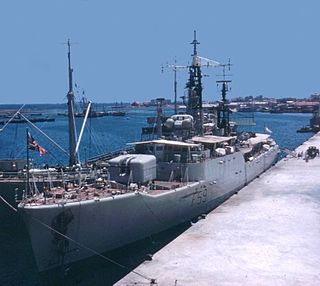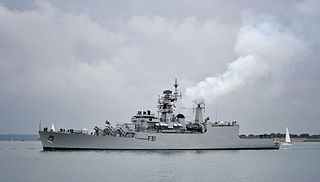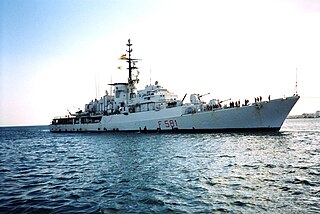
INSVikrant was a Majestic-class aircraft carrier of the Indian Navy. The ship was laid down as HMS Hercules for the British Royal Navy during World War II, but was put on hold when the war ended. India purchased the incomplete carrier in 1957, and construction was completed in 1961. Vikrant was commissioned as the first aircraft carrier of the Indian Navy and played a key role in enforcing the naval blockade of East Pakistan during the Indo-Pakistani War of 1971.

HMS Lynx (F27), was a Leopard-class Type 41 anti aircraft frigate of the Royal Navy, named after the lynx.

HMS Chichester was a Salisbury-class or Type 61 aircraft direction frigate of the British Royal Navy.

INS Khukri was a Type 14 (Blackwood-class) frigate of the Indian Navy. She was sunk off the coast of Diu, Gujarat, India by the Pakistan Navy Daphné-class submarine Hangor on 9 December 1971 during the Indo-Pakistani War of 1971. This was the first warship sunk in action by a submarine since World War II. It remains the post-independence Indian navy's only warship to be lost in war.
Operation Dwarka, codenamed as Operation Somnath, was a naval operation by the Pakistan Navy to attack the Indian coastal town of Dwarka on 7 and 8 September 1965. This instance was the first engagement by the Pakistan Navy in any of the Indo-Pakistan Wars.

INS Brahmaputra (F31) is the lead ship of her class of guided missile frigates of the Indian Navy. She was built at the Garden Reach Shipbuilders and Engineers (GRSE), Kolkata.
HMS Bodenham was one of 93 ships of the Ham-class of inshore minesweepers. Completed in 1953 for use in the British Royal Navy, she served as a tender to HMS Vernon between 1954 and 1955 before being placed in reserve. In 1967 she was transferred to the newly-independent country of South Yemen renamed Al Saqr. She was renamed Jihla in 1975 and discarded in 1984.
HMS Leopard (F14), was a Leopard-class Type 41 anti aircraft frigate of the British Royal Navy, named after the leopard.
Following ships of the Indian Navy have been named Brahmaputra:

The Commandant Rivière class was a class of frigates built for the French Navy in the late 1950s and early 1960s. Labeled "aviso-escorteur", they were designed to perform the role of overseas patrol in peacetime and anti-submarine escort in wartime. This vessel class is named after the French Navy officer Henri Rivière (1827–1883).

The Alpino class were a group of two frigates built for the Italian Navy during the Cold War.

The Le Normand class was a class of 14 fast frigates built for the French Navy in the late 1950s. They were an immediate follow-on from the earlier Le Corse-class frigates, and like them, were long-range convoy escorts capable of high speed. The first seven ships, paid for by the United States under the Mutual Defense Assistance Act were ordered in 1952. The remaining seven ships were paid for by France and ordered between 1953 and 1955.
The Indo-Pakistani Naval War of 1971 refers to the maritime military engagements between the Indian Navy and the Pakistan Navy during the Indo-Pakistani War of 1971. The series of naval operations began with the Indian Navy's exertion of pressure on Pakistan from the Indian Ocean, while the Indian Army and Indian Air Force moved in to choke Pakistani forces operating in East Pakistan on land. Indian naval operations comprised naval interdiction, air defence, ground support, and logistics missions.

The Bergamini class was a class of four frigates operated by the Italian Navy. They entered service in 1961, with the last one being stricken in 1988.

The Audaz class was a class of nine destroyers built for the Spanish Navy after the Second World War. Construction was slow, with only four completed to the original design from 1953–1956. The remaining five ships completed as anti-submarine escorts with a new armament and sensor fit from 1960 to 1965, while the original four ships were also modified to this standard. Built at Ferrol, they completed in 1946–1950 and were rated as gunboats, and were redesignated as frigates in 1959. The last of the class, Intrepido, was stricken in 1982.
The Pizzaro class was a class of eight escort vessels built for the Spanish Navy in the 1940s. Built at Ferrol, they were completed in 1946–1950 rated as gunboats, and were redesignated as frigates in 1959. They started to be withdrawn from use in 1968, with the last of the class, Vincente Yañez Pinzon, stricken in 1982.
INS Beas was a Leopard-class frigate of the Indian Navy. She was launched by Vickers-Armstrong Ltd at Newcastle upon Tyne in 1958 and completed in 1960. Beas served in the Battle at Mormugão harbour 1961 and during the Indo-Pakistani War of 1971. She was stricken by the INS in 1988 and scrapped in 1992.
Vice Admiral Elenjikal Chandy Kuruvila, PVSM, AVSM was a former Flag officer in the Indian Navy. He was the Fleet commander of the Western Fleet during the Indo-Pakistani War of 1971, for which he was awarded the Param Vishisht Seva Medal. He later led the Southern Naval Area and then served as the chairman and managing director of Mazagon Dock Limited.
Vice Admiral Kankipati Appala Satyanarayana Zagapathi 'KASZ' Raju, PVSM, AVSM, NM is a former Flag officer in the Indian Navy. He last served as the Flag Officer Commanding-in-Chief Western Naval Command, from 1992 to 1994. A naval aviator, he was part of the Navy's first naval air squadron INAS 300 and was embarked on the Navy's first aircraft carrier INS Vikrant. During the Indo-Pakistani War of 1971, he was the executive officer of the Leopard-class frigate INS Brahmaputra (1957), for which he was awarded the Nao Sena Medal. He later commanded the Western Fleet and the Southern Naval Command.









